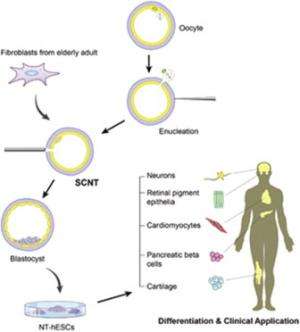Credit: Cell Stem Cell, DOI: 10.1016/j.stem.2014.03.015
(Phys.org) —An international team of researchers, led by Robert Lanza, of Advanced Cell Technology, has announced that they have performed the first successful cloning of adult human skin cells into stem cells. A paper by the team describing their work has been published in the journal Cell Stem Cell.
The achievement by the team is actually a replication of work done by another team just last year—in that effort the team did the same thing but used donor cells from infants. In this new experiment, two men aged 35 and 75 donated skin cells.
Technically called somatic-cell nuclear transfer aka "therapeutic cloning" the process is similar to that used to clone Dolly the sheep back in 1997. Since that time, researchers have run into a myriad of obstacles in achieving the same results in humans, though it should be noted that there is a major difference in objective—with humans, the aim is to clone stem cells so that they can be used to treat diseases, not reproduce whole human beings.
To clone the stem cells, the researchers used unfertilized eggs donated by several unidentified women. After removing the DNA material inside the egg, new DNA material extracted from the skin cells of the male donors was injected inside and the resulting filled egg was exposed to a small dose of electricity to cause fusing—the egg was then allowed to "rest" for two hours. Afterwards each egg reprogrammed itself and grew into a blastocyst which eventually grew into a pluripotent stem cell that genetically matched the skin donor. Theoretically such stem cells could then be engineered to grow into various cells, e.g. heart, lung, liver, for transplant into a patient.
Funding for the research was provided by an unnamed foundation and the Korean Government—the experiments were conducted in a lab in California. The researchers point out that the process cannot be used to create a whole human being.
The team notes that despite their success, there is still a lot of work to do before cloned stem cells become a viable option for treating medical problems in people. They note that out of 77 eggs donated and used in the experiments, only two led to successful cloning—one from each of the male donors. Their experiments do prove however, they add, that successful cloning of human stem cells is possible with donors of any age.
More information: Human Somatic Cell Nuclear Transfer Using Adult Cells, Cell Stem Cell, dx.doi.org/10.1016/j.stem.2014.03.015
Summary
Derivation of patient-specific human pluripotent stem cells via somatic cell nuclear transfer (SCNT) has the potential for applications in a range of therapeutic contexts. However, successful SCNT with human cells has proved challenging to achieve, and thus far has only been reported with fetal or infant somatic cells. In this study, we describe the application of a recently developed methodology for the generation of human ESCs via SCNT using dermal fibroblasts from 35- and 75-year-old males. Our study therefore demonstrates the applicability of SCNT for adult human cells and supports further investigation of SCNT as a strategy for regenerative medicine.
Journal information: Cell Stem Cell
© 2014 Phys.org























